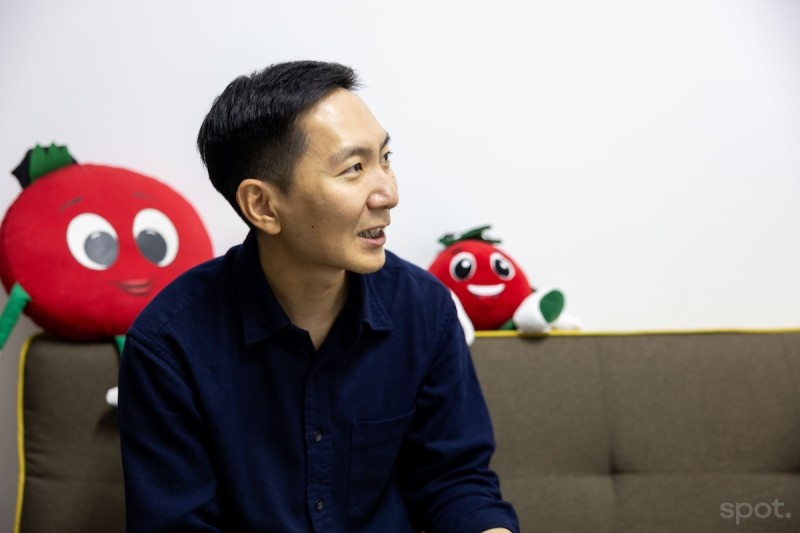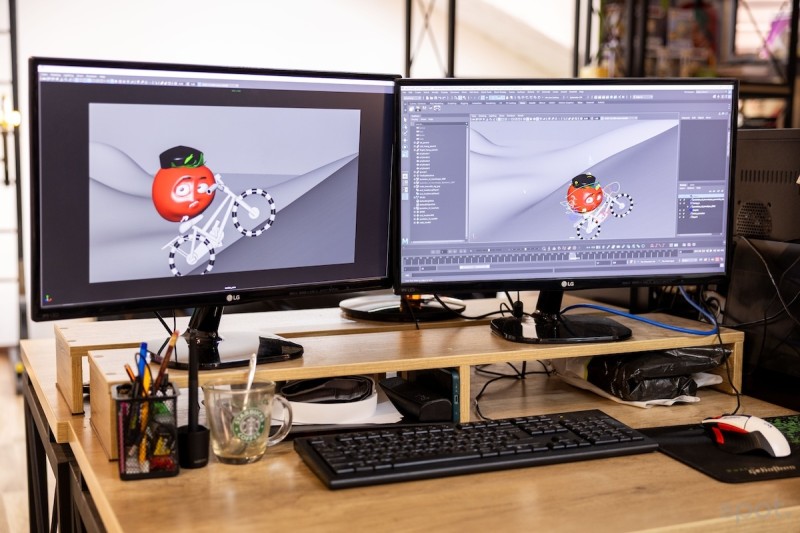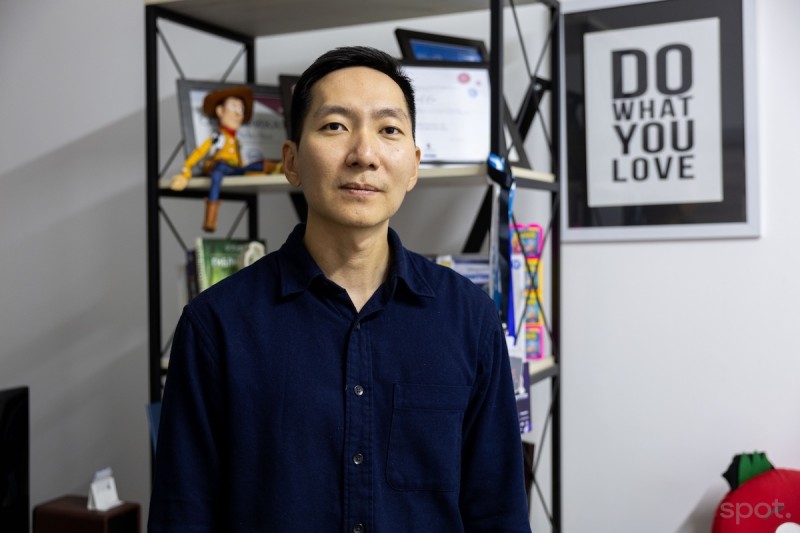
Pomidor Doppi: How an Uzbek Animated Series Reached Global Streaming Platforms
Pomidor Doppi, an animated series from Uzbekistan, is now streaming on over 50 platforms across CIS countries, as well as in China and Spain. We spoke with the founder of DIP Animation, the studio behind the series, about the production costs and profitability of such projects, the process of adapting content for international markets, as well as the current state of Uzbekistan’s animation industry.

This article was prepared in collaboration with Spot.uz as part of a new column focusing on startups, venture investments, and the development of Uzbekistan’s IT sector.
Driven by a lifelong passion for creating cartoons, Pavel Kim transitioned from independently mastering 3D animation to establishing his own studio, DIP Animation. His first major project, Pomidor Doppi, initially began as an experimental endeavor but has since expanded to numerous platforms, including Kinopoisk, IVI, and KION. Recently, the series was adapted for Spanish- and Chinese-speaking audiences.
The YouTube channel hosting all episodes of Pomidor Doppi has amassed nearly half a million subscribers. However, due to the absence of monetization on the platform in Uzbekistan, the studio incurred an estimated loss of $80,000 in potential revenue.
Beyond digital platforms, the series has also been featured in cinemas, aired on Uzbekistan Airways flights, and broadcast on national television.
In this interview, Pavel Kim shared insights into the average cost of producing a single episode, revenue-generating opportunities for animated content, as well as the challenges and prospects within Uzbekistan’s animation industry.
From Childhood Passion to Professional Career
Since childhood, I have been passionate about drawing and aspired to create animated films. My initial exposure to 3D graphics came through the Korean Educational Center, where I acquired a solid foundation. Following this, I dedicated an entire year to independently studying 3D animation, immersing myself in tutorials and continuously refining my craft.
Prior to establishing my own studio, my professional journey was closely tied to animation. I began my career at an advertising agency, where I was responsible for producing animated content for commercials. Subsequently, I spent two years in Moscow, working on projects for major corporations such as Gazprom and Russian Railways (RZD). Concurrently, I pursued studies in traditional animation under Alexander Dorogov — a seasoned animator with a decade of experience at Disney, contributing to iconic projects like The Lion King and Lilo & Stitch.
In 2014, I returned to Uzbekistan and joined Milliy TV channel as the supervisor of the computer graphics department. Before the channel’s official launch, our team engaged in a variety of projects, including the creation of animated films, commercial advertisements, and music videos. Notably, the music video for the song Illusion by Kamilla was one of our productions. Simultaneously, I pursued further education in screenwriting and directing at the school of Zulfikar Musakov.
By 2017, I came to the realization that I was finally ready to turn my long-held dream into reality — producing my own animated films. With this vision in mind, I made the decision to establish my own studio, fully dedicating myself to animation and 3D graphics.

The process of launching the studio closely resembled that of a typical garage startup. We secured a modest workspace, carried out basic renovations, and acquired two computers. Given the limited initial capital, we reinvested into the business as it progressed.
The name DIP is an acronym for Dream It’s Possible. The company was not initially conceived as a business concept but rather emerged from a personal dream — to create animated films.
Initially, I anticipated rapid success, believing that the studio would soon be producing multiple animated series and commercial projects. However, reality proved to be far more challenging — within the first six months, we had completed only a single commercial order. Our first animated series, Pomidor Doppi, was developed entirely on our own initiative, with no certainty as to whether it would ultimately be acquired by television networks or streaming platforms.
The Emergence of Pomidor Doppi
The concept for Pomidor Doppi originated in 2015 while I was employed at Milliy TV. Our team explored the idea of producing animated series and full-length animated films. As an initial experiment, we created a short clip titled "The Crying Tomato", which rapidly gained popularity. This served as a preliminary test to gauge audience reception and assess the viability of the concept.
The character itself was conceptualized by the channel’s producer, who proposed developing a protagonist inspired by his favorite vegetable — a tomato. Following this, we proceeded with the design of its visual identity and personality.
Once the clip went viral, we initiated script development and began structuring Pomidor Doppi as a full-fledged animated project. By that time, I had already transitioned away from full-time employment and was further developing these ideas within my own studio.
In the early stages, I assumed multiple roles simultaneously. For instance, in the first episode of Pomidor Doppi, I personally executed at least half of the production work. In standard animation processes, each stage is handled by specialized professionals; however, at that time, most of the tasks fell to me. Beginning with the second episode, we gradually implemented task delegation, and today, the production of each episode involves a team of 10 to 12 professionals. This team includes 3D generalists (versatile artists responsible for creating three-dimensional objects), modelers (specialists in developing 3D models using graphic software), riggers (experts who prepare characters for animation by constructing skeletal structures and control systems), animators, compositors (responsible for refining the final visual output), and special effects artists. Certain team members perform multiple functions. Additionally, the production team comprises scriptwriters, illustrators, concept artists, a sound designer, and a composer, some of whom operate remotely.
A significant number of our scripts are inspired by real-life scenarios. For example, one episode features Pomidor confronting a swarm of bees, metaphorically reflecting workplace challenges: a supervisor demands results, but employees remain indolent, distracted by personal devices, and fail to meet productivity expectations.
The scriptwriting process begins with the development of a premise — a concise summary of the episode’s core narrative. If the concept is deemed viable, the scriptwriter expands upon it, and the script undergoes multiple revisions. During this process, we eliminate extraneous elements, incorporate marketing considerations, and adapt the content for different markets. For instance, when targeting European and Russian audiences, particular attention is given to safety considerations — any scenes that children might attempt to replicate are either removed or adjusted to prevent unintended consequences. Maintaining a balance between creativity and responsibility toward our audience remains a fundamental priority.
Over the past eight years, we have produced 42 episodes, each with a duration of 3.5 minutes. New episodes are released on a monthly basis. Prior to distributing the series to streaming platforms, we launched a YouTube channel to share new episodes. The channel has since accumulated approximately 500,000 subscribers and generated a total of 270 million views.
Global Journey of Pomidor Doppi
Following the production of 22 episodes, we commenced discussions with streaming services and television networks to distribute our animated series. Today, Pomidor Doppi is available on more than 50 online platforms across the CIS, including major services such as Kinopoisk, IVI, START, KION, Megogo, and iTV. In most instances, we initiated contact with these platforms, however, there were also cases where they reached out to us directly.
The financial terms of collaboration vary depending on the platform. Agreements are generally structured either as a fixed payment per episode or as a revenue-sharing arrangement based on viewership metrics or subscriber engagement.
Building on the series' success within the CIS, we expanded our distribution strategy to international markets, with a particular focus on Spain and China. In 2023, Pomidor Doppi was officially launched in Spain. For this market, we adapted the theme song, localized episode titles and credits. This process primarily involved reassembling the episodes with new audio tracks and text.
The localization process was fully financed by our studio. We collaborated with professional recording studios, where native speakers provided voiceovers, while our internal specialists handled technical aspects such as editing, synchronization, and subtitle adjustments.

Initially, revenue generation remained modest, averaging only $20–30 per quarter. However, by the end of 2024, earnings increased significantly, reaching approximately $2,000 per quarter.
Following the Spanish release, we turned our attention to the Chinese market, renowned for its complexity. Our objective was to refine the entire localization process through Pomidor Doppi, laying the groundwork for future endeavors in the region.
The Chinese market presents a number of challenges, including foreign content quotas, licensing requirements, and extensive bureaucratic procedures. Despite our thorough preparation, we encountered unforeseen difficulties, such as changes in legislation and fluctuations in content quotas.
Adapting the series for the Chinese market necessitated content modifications. For instance, since the depiction of globes is prohibited in China, we digitally altered scenes in which a globe appeared on Pomidor’s bookshelf — a revision that impacted 15 episodes.
The Chinese distribution team conducted a comprehensive review of the material and provided feedback, which we incorporated into the final version. Although the series features an opening theme song, it is largely non-verbal, thereby eliminating the need for extensive dubbing. The Chinese distributor recorded the opening song in their language, adapted the logo, and provided translations of episode titles and credits. Our team then integrated all elements into the final production. The overall process, from contract execution to the series' official release in China, spanned approximately 18 months.
In September 2024, Pomidor Doppi premiered in China, with the series available in Chinese across 45 online platforms. The costs associated with adaptation and licensing were recouped almost immediately.

Beyond streaming services, Pomidor Doppi is also available on Uzbekistan Airways flights. We independently proposed a partnership, and the national airline welcomed the initiative. We also contribute to the in-flight magazine by creating a dedicated children’s section featuring interactive puzzles and activities inspired by the series’ characters.
The series has also been introduced to cinema audiences. A curated selection of the most popular episodes has been compiled into a special feature, "Best Episodes on the Big Screen", which is currently being screened at Compass cinemas. The 30-minute format is ideal for children’s first cinema experience, offering a large screen, immersive sound, and familiar characters.
On television, Pomidor Doppi continues to be broadcast regularly on Milliy TV and was previously aired on Russia’s Karusel channel. We are currently exploring opportunities for collaboration with Uzbekistan’s national children's channel, Bolajon.
The Business of Animation
The studio's primary source of revenue is the production of animated commercials. The cost of a single commercial varies between $1,000 and $10,000, depending on its complexity, scope, and the number of specialists involved. Our portfolio includes collaborations with leading international brands such as KFC, Yandex, Osstem, Adrenaline Rush, Rollton, and Gazprom, as well as prominent Uzbek companies, including Evos and Bliss.
Remarkably, we operate without a dedicated sales department. Instead, all projects are acquired through word-of-mouth recommendations, reflecting the consistently high quality of our animation. We maintain a core in-house team, supplemented by a reliable network of freelance specialists whom we engage as needed. This approach enables us to undertake large-scale projects with confidence.
The production costs associated with animated films and commercials are relatively high, averaging between $50 and $200 per second of animation. Compared to Russian studios, our production expenses are two to three times lower, despite utilizing identical equipment. The cost differential is largely attributable to lower salaries, which are 30–50% lower in Uzbekistan.
The cost per episode is further reduced by the fact that one specialist often handles multiple tasks. For instance, in Russia, the average budget for a full-length animated film is approximately $4 million, and achieving a lower production cost typically entails a compromise in quality. In Uzbekistan, such budgets remain unavailable for animation projects. However, large-scale investments in the industry often yield substantial returns. A notable example is Cheburashka, produced by Soyuzmultfilm, which incorporated live-action and CGI elements. Despite a production cost of approximately $7 million, the film grossed $70 million at the box office, recouping its costs many times over.
In many respects, animation resembles the startup ecosystem, as it requires long-term investments akin to venture capital funding, where returns are not always predictable. The production of animated content entails substantial expenditures over an extended period, and only a limited number of projects achieve significant profitability. The industry operates on a portfolio-based approach: if you launch 5–10 projects, one might succeed, potentially compensating for the costs of the others manifold, sometimes by tens or hundreds of times.
As our animation projects are not yet a major source of profit, we continue to sustain operations through other revenue streams while maintaining a firm belief in the industry's potential. Our long-term objective is to transition away from commercial advertising in favor of developing original creative content. For instance, we recently released a short film titled Earth and Moon, which was entirely self-funded.
Additionally, we are currently developing "Elementarno", an educational animated series created in partnership with international studios. Designed for a global audience, this children’s project is undergoing script revisions by industry professionals who have previously collaborated with Cartoon Network and Nickelodeon Junior. In addition to entertainment, we incorporate elements designed to foster emotional intelligence in children, helping them understand and manage their emotions learn about friendship, and explore feelings such as anger, joy, and fear.
Furthermore, we are planning to launch a project incorporating artificial intelligence. While we believe AI represents the future, we currently lack sufficient control over correcting its errors. For us, it is crucial to meticulously develop animation and maintain character consistency, which AI does not always achieve. It offers options, but we require precise results.
One of the most significant non-commercial projects I participated in was the production of a music video for DJ Avicii. In 2013, prior to founding the studio, I took part in the Talent House competition in collaboration with a beverage brand affiliated with the Lotus F1 Team. The objective was to develop a concept for the music video of Avicii’s track Speed.
I decided to undertake the challenge and see what would result. For a month, I worked on the video every night after my day job, often until 3 a.m. Upon completion, I submitted the video and moved on, as other projects garnered more likes and my video slipped down the rankings. However, some time later, I received an unexpected call informing me that my entry had been selected as the winner. This news came as a complete surprise, and I was awarded a $4,000 prize.
Following my selection, I was requested to refine the video by incorporating logos and sponsor emblems on the cars and drivers’ uniforms. To facilitate this process, I was granted access to the Lotus F1 Team’s official design database, which contained all proprietary branding assets.

The Animation Industry in Uzbekistan
The comprehensive development of Uzbekistan’s animation market necessitates a multifaceted approach. One of the foremost challenges is the absence of a robust infrastructure. The country currently lacks a well-established distribution or licensing market, which significantly hinders the promotion of local animation projects. For Uzbek studios to achieve international recognition, active participation in major global industry events is essential. For instance, the Annecy International Animation Film Festival, which hosts an International Animation Film Market alongside its competition program, provides a valuable platform for showcasing films for distribution.
Another pressing issue is the shortage of skilled professionals. Uzbekistan faces a deficit of animators, scriptwriters, producers, and post-production specialists. Even if international companies were to consider outsourcing projects to Uzbekistan, the existing talent pool would be insufficient to meet the required scale and quality standards.
Furthermore, the unavailability of YouTube monetization in Uzbekistan limits revenue generation on digital platforms. This restriction has resulted in a loss of approximately $80,000 in potential earnings for our studio.
We remain optimistic that the situation will improve in the future, creating a strong incentive for local content creators. We believe that Uzbek animation has the potential to become a globally sought-after export product. Our competitive advantage lies in our ability to produce content of international quality at a lower cost.
At present, there is a notable scarcity of children’s animation in the country. For example, if all existing episodes of Pomidor Doppi were broadcast on television, they would fill only a single day of programming on a TV channel. In contrast, the Russian channel Karusel airs exclusively domestic cartoons around the clock.
The animation industry in Uzbekistan is still in its nascent stages. While the current development process involves trial and error, over time, as the market stabilizes, clear mechanisms for collaboration with international partners, licensing, and distribution will emerge. This evolution will unlock new opportunities for the entire industry.
Uzbekistan possesses immense potential: with a population approaching 38 million, a significant portion of which is young. Over the next 5–10 years, the demand for children's animation will only increase, creating new opportunities for market growth.
Uzbekistan is increasingly establishing itself on the global stage for creative services, and companies like DIP Animation serve as exemplary cases of successful international integration. With the support of IT Park Uzbekistan, companies gain access to essential resources for expansion and achieving new heights.
If you have a startup idea or are an existing startup in need of assistance, submit your application to StartupBase.
If you are an IT company planning to expand internationally, apply for the Local2Global program by IT Park.
2025-03-03